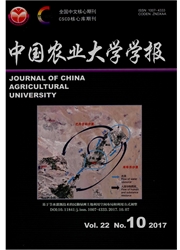

 中文摘要:
中文摘要:
运用DEA-Malmquist模型考察中国低碳农业生产率并利用Tapio脱钩模型探究农业碳排放与其之间的协调性。结果表明:1)我国农业碳排放总量上升趋势较为明显,但年际间也伴随一定的波动起伏;农业碳排放强度一直处于下降趋势;农用物资、稻田与牲畜养殖所引发的碳排放量均呈上升趋势,其中农用物资碳排放所占比重一直处于上升趋势,而稻田与牲畜养殖的占比均有不同程度降低。2)1993年以来,我国低碳农业生产率增速总体偏慢,年均仅为0.80%,基于其累计值的年际变化可划分为平稳起伏、波动下降和波动上升等3个阶段;从增长源泉看,农业前沿技术进步相比农业技术效率发挥了更为显著的作用。3)我国农业碳排放与低碳农业生产率之间的脱钩类型1993—2002年主要表现为强负脱钩和扩张负脱钩;而2002—2012年则多种脱钩状态共存但以弱脱钩为主。
 英文摘要:
英文摘要:
DEA-Malmquist model is adopted to investigate the low-carbon agriculture productivity in China, and the correlation between China' s agricultural carbon emissions are then discussed and the low carbon agriculture productivity was investigated by using Tapio decoupling. The results show that= 1 ) The upward trend of the total agricultural carbon emission in China is obvious, while there exist certain ups and downs. The intensity of agricultural carbon emission has decreased. The trend of carbon emission that resulted from agricultural supplies, paddy fields and livestock keep rising. Among them,the proportion of agricultural supplies carbon emission increases with the proportion decrease of paddy fields and livestock at different degree; 2) China' s low-carbon agricultural productivity keeps growing at an annual rate of 0.80% from 1993,and according to the interannual variation of cumulative data. It can be divided into three stages, namely smooth undulating stage, wave decline stage and volatility rise stage. Agricultural frontier technology progress has played more significant effects on growth sources than agricultural technology efficiency ;3) The decoupling type between China's agricultural carbon emission and its carbon agricultural productivity is mainly strong negative decoupling and expanding negative decoupling during the period of 1993 - 2002. Though there are many kinds of decoupling coexist in 2002- 2012, the weak decoupling is the principal type.
 同期刊论文项目
同期刊论文项目
 同项目期刊论文
同项目期刊论文
 期刊信息
期刊信息
